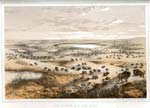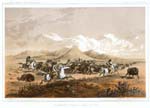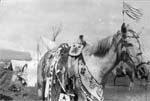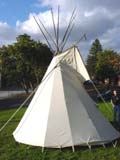|
References The Schitsu'umsh history outlined on this and the next pages is more fully developed and discussed in the following two books.
Frey, Rodney in collaboration with the Schitsu'umsh. 2001. Landscape Traveled by Coyote and Crane: The World of the Schitsu'umsh (Coeur d'Alene Indians). Seattle and London: University of Washington Press.
Kowrach, Edward and Thomas Connolly, edited. 1990. Saga of the Coeur d'Alene Indians: An Account of Chief Joseph Seltice. Ye Galleon Press: Fairfield, Washington.
Links For more information on buffalo, consider visiting:
Bison in the Pierre, SD module.
|
|
 | | Montana Buffalo, ca. 1853 |
It is likely that by the 1760s the horse had become a fully integrated member of the Schitsu’umsh family. The horse was reintroduced into Indian country by the Spanish, and then came north from Mexico by inter-tribal trade and as wild herds began spreading out over the land. With the horse, travel to distant places was made easier, such as treks to hunt buffalo in the lands east of the Bitterroot Mountains or to Kettle Falls to the northwest to trade for salmon. But as Lawrence Aripa always pointed out, "we didn’t go to buffalo country just to hunt. We always had plenty of deer and elk to hunt right here. We went to learn different things and they’d say, 'The children would leave as children and they’d come back as grown-ups.'" Listen as Lawrence tells you the story of Four Smokes. And with the coming of the horse came the use of the hide-covered tipi (later replaced by trade canvas) as a more mobile form of lodging, as well as the need to continually find good grazing pastures for the growing horse herds. But with the increased mobility also came greater confrontation with traditional enemies, such as the Blackfeet and Crow. While in Buffalo country an eye always had to be alert to the horizon for a war party seeking to "count coup" and acquire "slaves." While there were also occasions when Crow warriors traveled into Schitsu’umsh country, they were always repulsed by the Schitsu’umsh.
 | | Buffalo Hunters, ca. 1853 |
But another influence was introduced by Europeans that was far from welcomed - smallpox and other infectious diseases, such as chickenpox, measles, and whooping cough. A continuous series of epidemics spread rapidly beginning as early as the 1770s. As with the other tribes, the Schitsu’umsh had no natural immunity from these deadly "bugs." It is estimated that the Schitsu’umsh numbered some 5,000 individuals prior to these epidemics, and that by the 1850s their numbers were reduced to a total of some 500 souls. As the elderly and young were particularly susceptible, considerable tribal wisdom and the dreams of a future generation were thus lost. The numbers of able-bodied warriors were fewer and the dangers from the Blackfeet greater. If you had been able to survive this devastation, dying of old age in the 1850s, you would have witnessed nearly every Schitsu’umsh you knew die a horrible death. One cannot imagine the terror and sorrow felt.
 | | Beaded Horse Regalia | Three years after meeting with Lewis and Clark, David Thompson of the Northwest Fur Company built a fur trading post on the border of Schitsu’umsh country. Kullyspell House is located near the present town of Hope, Idaho on the eastern shores of Lake Pend Oreille. The following year in 1810, Jaco Finlay built Spokane House, a short distance downriver from Spokane Falls. By 1821 the Northwest Fur Company had merged with the Hudson’s Bay Company and it had a virtual monopoly on the fur trade in the Pacific Northwest. While the fur trade was relatively short-lived, all but ending by the 1840s, it had a significant and lasting influence on the Schitsu’umsh.
 | | The Tipi |
In exchange for animal furs, numerous trade items were introduced, including glass beads, wool blankets, cotton shirts, knives and axes, cooking pots, arrow points and eventually rifles. The exchanges often occurred at great annual "rendezvous," a time and place for games, family renewal and serious trading. It was during these exchanges that Schitsu’umsh became acquainted with ideas of capitalism and the notion that animal skins had a monetary value and could be viewed as a commodity. Also keep in mind that it was under these circumstances, and with these entrepreneurial and not-always-honest traders and trappers, that the Schitsu’umsh got their first extended view and developed their initial impressions of the suyepmsh. It was also during this time that the Indian populations were introduced to alcoholic drink, and their lives would never be the same. As the fur trade was closely tied to the oscillations of the global market, when the European demand for beaver-felt hats waned, so too did the ability to acquire those new trade items that the Schitsu’umsh had become reliant upon. When gun-powder and lead shot for muskets became far more difficult to obtain, hunters found it more difficult to secure venison for their families. The first taste of Euro-American induced "poverty" was experienced.
And with the fur trade came a new name for the Schitsu’umsh. While not entirely clear, it was likely French-speaking fur traders, of either European or Iroquois descent, who began calling the Schitsu’umsh - the "Coeur d’Alene." The term refers to the "heart of an awl," and characterizes the tough bargaining practices of the Schitsu’umsh. In his journals, David Thompson simply referred to the Schitsu’umsh people as the "Pointed Hearts."
© Coeur d'Alene Tribe 2002
< previous |
next >
|
|
|







